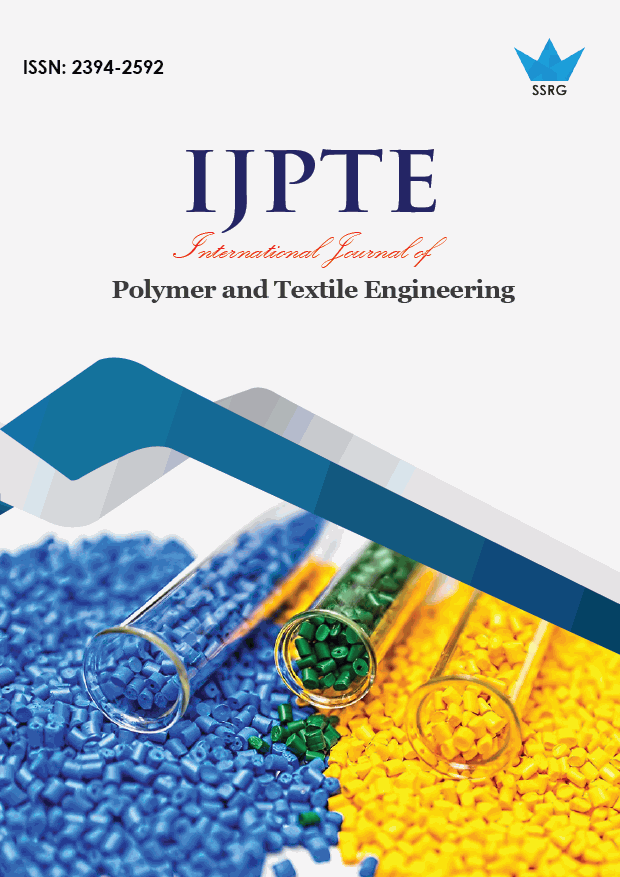Design and Development of Bilayer Composite using Different Cross-linkers

| International Journal of Polymer and Textile Engineering |
| © 2020 by SSRG - IJPTE Journal |
| Volume 7 Issue 3 |
| Year of Publication : 2020 |
| Authors : Preeti Gupta, Roli Purwar |
How to Cite?
Preeti Gupta, Roli Purwar, "Design and Development of Bilayer Composite using Different Cross-linkers," SSRG International Journal of Polymer and Textile Engineering, vol. 7, no. 3, pp. 12-17, 2020. Crossref, https://doi.org/10.14445/23942592/IJPTE-V7I3P102
Abstract:
Composites can be assumed as a boon for enhancing the mechanical strength of hydrogels. In the present study, bilayer composites are developed using cotton substrate and poly (acrylamide –co –acrylic acid) hydrogel system through free radical polymerization. The parameters for the development of bilayer composites were optimized in terms of grafting yield. The maximum grafting with 0.1 % by (w/w) PEG and 0.3% (w/w) MBAAm was 102% and 184%. The optimised conditions for maximum grafting (0.23 ± 0.08 mm thick layer) were initiator concentration 5% (w/V),monomer molar ratio 1:1, monomer concentration 15%, reaction time 55 minutes and reaction temperature 50C. Morphology of the composites was characterized by Fourier Transform Infrared spectroscopy (FTIR), and their mechanical properties were tested using Universal Tensile Machine (UTM). The stress-strain curve data suggests higher mechanical strength of composites as compared to hydrogel film. These results support the reinforcement of the strength of the hydrogel after converting it into a composite.
Keywords:
Bilayer composite, Cross-linker, Grafting, Hydrogel, Mechanical strength
References:
[1] B. Isik and M. Kis, -"Preparation and determination of swelling behavior of poly(acrylamide-co-acrylic acid) hydrogels in wate"r, J. Appl. Polym. Sci. 94, 1526–1531,2004.
[2] R. S. Tomar, I. Gupta, R. Singhal, and A. K. Nagpal, - "Synthesis of poly(acrylamide-co-acrylic acid)-based superabsorbent hydrogels by gamma radiation: Study of swelling behavior and network parameter". Des. Monomers Polym. 10, 49–66,2007.
[3] M.C. I. Mohd Amin, N. Ahmad, M. Pandey, and C. Jue Xin,-"Stimuli-responsive bacterial cellulose-g-poly(acrylic acid-co-acrylamide) hydrogels for oral controlled release drug delivery", Drug Dev. Ind. Pharm., 40, 1340–1349,2014.
[4] X. Liu, J.Liu, S. Lin, and X. Zhao,- "Hydrogel machines", Mater. Today, xxx, 14–19,2020.
[5] D. Şolpan, S. Duran, D. Saraydin, and O. Güven,- "Adsorption of methyl violet in aqueous solutions by poly(acrylamide-co-acrylic acid) hydrogels", Radiat. Phys. Chem. 66, 117–127, 2003.
[6] H. L. Gonçalves, P. Bogalhos Lucente Fregolente, M.R. Wolf Maciel, and L.V. Fregolente,-"Formulation of hydrogels for water removal from diesel and biodiesel", Sep. Sci. Technol. 00, 1–15,2020.
[7] A. Guleria, G. Kumari, and E.C. Lima,- "Cellulose-g-poly-(acrylamide-co-acrylic acid) polymeric bio adsorbent for the removal of toxic inorganic pollutants from wastewaters", Carbohydr. Polym. 228, 115396, 2020.
[8] M.J. Zohuriaan-Mehr, H. Omidian, S. Doroudiani, and K. Kabiri,-"Advances in non-hygienic applications of superabsorbent hydrogel material"., J. Mater. Sci., 45, 5711–5735, 2010.
[9] N. Kubota, N. Tatsumoto, T. Sano, and Y. Matsukawa,- "Temperature-responsive properties of poly(acrylic acid-co-acrylamide)-graft-oligo(ethylene glycol) hydrogel". J. Appl. Polym. Sci, 80, 798–805, 2001.
[10] D. E. Owens, Y. Jian, J. E. Fang, B.V. Slaughter, Y.H. Chen, and N.A. Peppas- "Thermally responsive swelling properties of polyacrylamide/poly(acrylic acid) interpenetrating polymer network nanoparticles", Macromolecules, 40, 7306–7310,2007.
[11] M. Yang, C. Liu, Z. Li, G. Gao, and F. Liu,- "Temperature-responsive properties of poly(acrylic acid-co-acrylamide) hydrophobic association hydrogels with high mechanical strength", Macromolecules, 43, 10645–10651,2010.
[12] A. Tangri,- 'Polyacrylamide Based Hydrogels : Synthesis, Characterization and Applications", International J. Pharm. Chem. Biol. Sci., 4, 951–959,2014.
[13] W. M. Cheng, X. M. Hu, Y. Y. Zhao, M. Y. Wu, Z. X. Hu, and X. T.Yu, - "Preparation and swelling properties of poly(acrylic acid-co-acrylamide) composite hydrogels", E-Polymers,17, 95–106,2017.
[14] R. Purwar, P. Rajput, and C.M. Srivastava,- "Composite wound dressing for drug release", Fibers Polym., 15, 1422–1428, 2014.
[15] F. Wu, Y. Zhang, L. Liu, and J. Yao, -"Synthesis and characterization of a novel cellulose-g-poly(acrylic acid-co-acrylamide) superabsorbent composite based on flax yarn waste", Carbohydr. Polym., 87, 2519–2525, 2012.
[16] G. R.Mahdavinia, A. Pourjavadi, H. Hosseinzadeh, and M. J. Zohuriaan,- "Modified chitosan 4. Superabsorbent hydrogels from poly(acrylic acid-co-acrylamide) grafted chitosan with salt- and pH-responsiveness properties", Eur. Polym. J., 40, 1399–1407,2004.
[17] J. Nath, A. Chowdhury, I. Ali, and S. K. Dolui, -"Development of a gelatin-g-poly(acrylic acid-co-acrylamide)–montmorillonite superabsorbent hydrogels for in vitro controlled release of vitamin B 12", J. Appl. Polym. Sci., 136, 1–11, 2019.
[18] X. Hu, - "Synthesis and properties of silk sericin-g-poly(acrylic acid-co-acrylamide) superabsorbent hydrogel", Polym. Bull., 66, 447–462, 2011.
[19] S. Nesrinne, and A. Djamel, "Synthesis, characterization and rheological behavior of pH-sensitive poly(acrylamide-co-acrylic acid) hydrogels", Arab. J. Chem.,10, 539–547, 2017.
[20] E.Turan, and C. Tuncer,- "Swelling and Network Parameters of pH-Sensitive Poly ( acrylamide- co -acrylic acid ) Hydrogels", J. Appl. Polym. Sci., 106, 2000–2007,2007.
[21] R.Khullar, V. K.Varshney, S.Naithani, and P. L. Soni, "Grafting acrylonitrile onto cellulosic material derived from bamboo (Dendrocalamus strictus)", Express Polym. Lett., 2, 12–18,2008.
[22] H. J. Chun, S. M. Cho, Y. M. Lee, H. K. Lee, T. S. Suh, and K.S. Shinn,- "Graft Copolymerization of Mixtures of Acrylic Acid and Acrylamide onto Polypropylene Film". J. appl. polym. sci.,72,251–256, 1999.
[23] Ming-Shien Yen, "Sol–Gel Derived Inorganic–Organic Hybrid Materials Comprising Vanadia, Silica, and Thiazole Dyes" SSRG International Journal of Applied Chemistry 5.2 (2018): 11-18.

 10.14445/23942592/IJPTE-V7I3P102
10.14445/23942592/IJPTE-V7I3P102